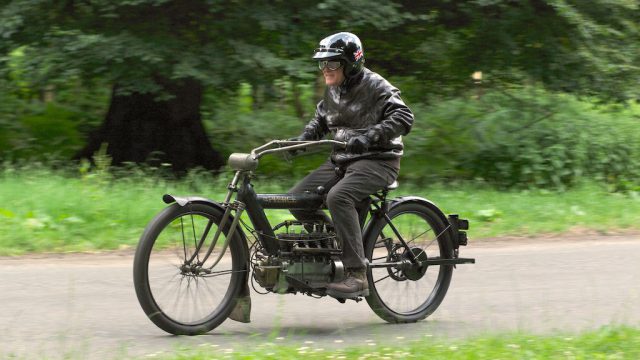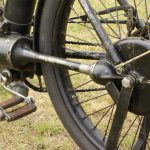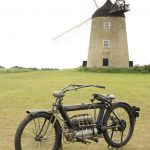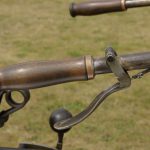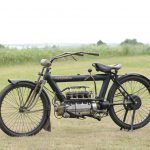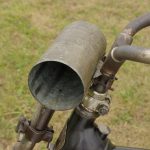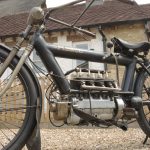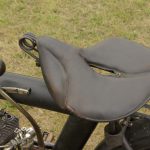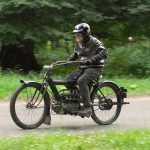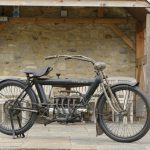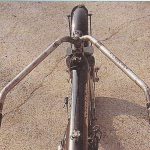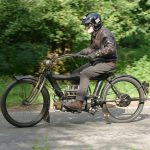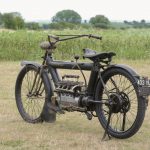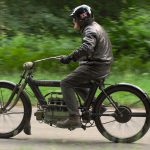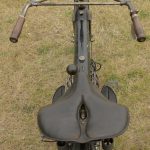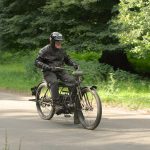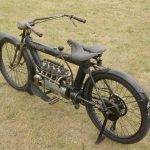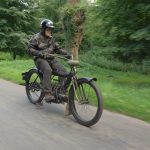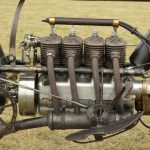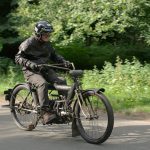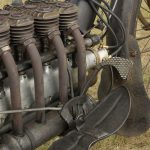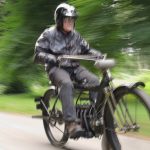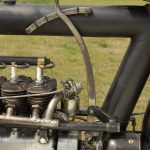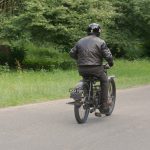Exclusive ride on a rare but important motorcycle in American two-wheeled history
Positively luxurious by the standards of the era, the 1909 Pierce was the first four-cylinder motorcycle to be manufactured in the USA for customer sale. At a time when most other motorcycles available for purchase were essentially spindly-framed bicycles fitted with often diminutive single- and twin-cylinder engines, the Pierce was substantial by comparison, yet decidedly avantgarde. With its massive tubular steel frame which at once set it apart from its rivals, it also stood out for the comparative smoothness of its four-cylinder engine that led to it being dubbed the ‘Vibrationless Motorcycle’.
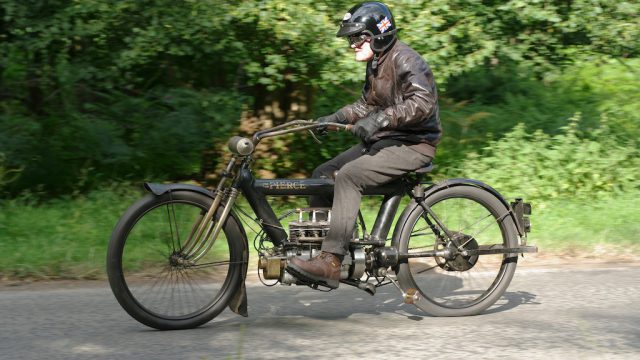
As a Pierce advert declared, “Pierce motorcycles are not made to compete in price, but to surpass in quality. It is a deluxe motorcycle for discriminating riders.” The fact that it traced its roots to the Pierce-Arrow Motor Car Co., maker of the most prestigious American cars then available, two of which were ordered in 1909 by US President William Howard Taft as the first official White House cars for use on state occasions, added further lustre to its appeal.
You can also read: 2017 BMW K1600B Bagger Video Review
BMW R1200GS vs Honda CRF1000L Africa Twin: in-depth review
The son of English migrants to the USA, George Norman Pierce was born in 1846 in Friendsville, Pa., but had moved to Buffalo, NY by the time he started a company there in 1865 known as Heinz, Pierce and Munschauer, makers of home furnishings such as bathtubs, birdcages and ice boxes. In 1872 Pierce bought out his two partners, and changed the firm’s name to the George N. Pierce Company, which in 1892 began making bicycles bearing what would become its famous Arrow badge. These were so successful that in 1895 it switched over to making them full time, many using a shaft drive for the rear wheel, rather than chain. Pierce then experimented in 1900 with a steam-powered car, but in 1901 after three members of its Board of Directors had travelled to Europe to acquire new technology, it built its first gasoline-powered automobile named the Motorette, using a De Dion single-cylinder engine imported from France. In 1903, it introduced a twin-cylinder car, the Arrow, now using the firm’s own motor, but business really took off with the 1904 debut of the larger, more luxurious Great Arrow, which became Pierce's most successful model. Driven by Percy Pierce, the son of the company’s owner, the solidly-built four-cylinder car won the debut Glidden Tour in 1905, a prestigious 1,100-mile endurance race from New York City to Bretton Woods, NH.
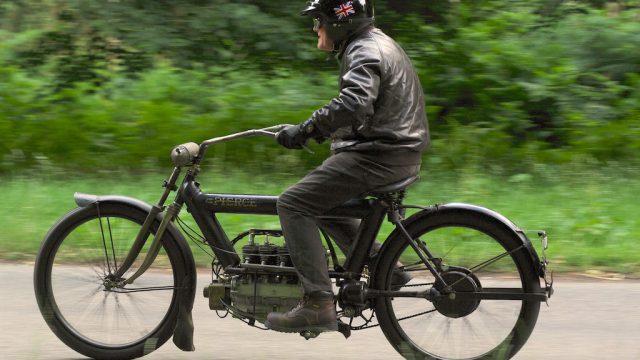
However, commercial success led to cashflow problems, with George Pierce only able to raise the capital to construct a much larger factory which opened in 1906 by bringing in outside investors. In due course, he became a minority shareholder in the company, and in 1907 was finally ousted from what would shortly be renamed the Pierce-Arrow Motor Car Co. in a deal which saw his share of the firm’s equity exchanged for full ownership of its pedal cycle subsidiary, which had continued making bicycles all this time. Pierce Senior passed away in 1910, but son Percy whom he’d put in charge of the Pierce Cycle Company, had by then developed the first four-cylinder motorcycle to be built in America, which entered production in 1909. For, true to their car company’s upmarket roots, the Pierces had wanted to kick off their motorcycle division with a high end luxury product. According to its makers the forthcoming Pierce Four would be 'Vibrationless, give motor car comfort, and travel comfortably from a mere walking pace up to the speed of the motor car.'

Indeed, having decided to enter the motorcycle market, Percy Pierce had travelled to Europe in 1908 in search of technical inspiration for the design of such models, and had acquired a 410cc Belgian-made shaft-drive four-cylinder FN, then the apogee of current motorcycle technology. This was shipped back to the Pierce factory in Buffalo to be used as a reference point for designing the American company’s much larger capacity and more substantial four-cylinder motorcycle – the Pierce Four, also with shaft final drive. This moreover represented a step forward technically compared to the FN, with its air-cooled in-line four-cylinder T-head motor with a valve on each side of the cylinders, fitted with cam-driven mechanical inlet valves and with fuel supplied by a single spray-type Breeze carburettor made in Detroit by George Breeze, who supplied them for Pierce-Arrow cars. This contrasted with the 'automatic' inlet valves of the Belgian bike’s ioe motor, which were pushed open by ambient air pressure against light springs during the piston's intake stroke, thus limiting engine revs and so performance.
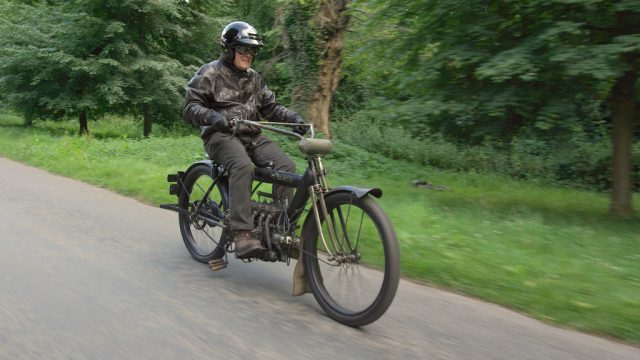
The wet-sump Pierce motor also featured mechanical lubrication via a gear-driven oil pump, instead of requiring the rider to remember to operate a syringe-like hand-pump periodically, as on the FN. Instead, he needed only occasionally to replenish the Pierce Four’s total-loss oil system’s supply of lubricant stored in the sump (claimed to be sufficient for 400-500 miles) by opening the tap on the secondary oil tank in the front frame tube, perhaps after checking the sight glass on the left side of the cast aluminium crankcase. This weighed 23kg, and was surmounted by four individual relatively lightly finned cast-iron cylinders.
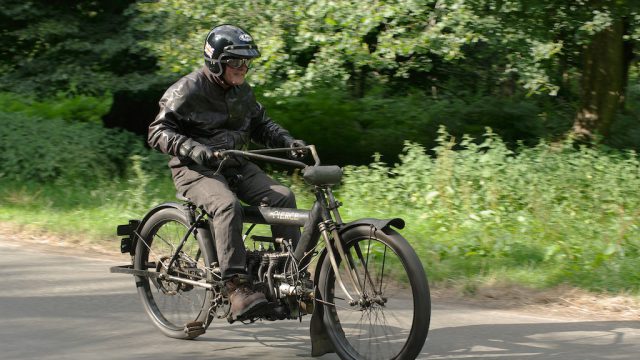
Like on the FN, the Pierce Four’s four-cylinder 651cc/40ci engine measuring 2.25 x 2.50 in (57.15 x 63.50 mm) was positioned lengthways in the frame, in which moreover it was used as a stressed member for extra stiffness and thus robustness, thanks to the chassis being made from very large 3.50in/89mm-diameter 18-gauge steel tubing. This was internally lined with copper to accommodate five US pints/2.37 litres of oil in the front down tube, and 1.75 US gallon/6.60 litres of fuel (claimed by Pierce to be sufficient for 175 miles of running) in the horizontal upper and rear down tubes, both topped up via small fillers just behind the steering head. The large diameter tubing both increased the frame's strength (a critical point given the often rough road conditions of the day) and reduced the number of parts required, making manufacture less costly.
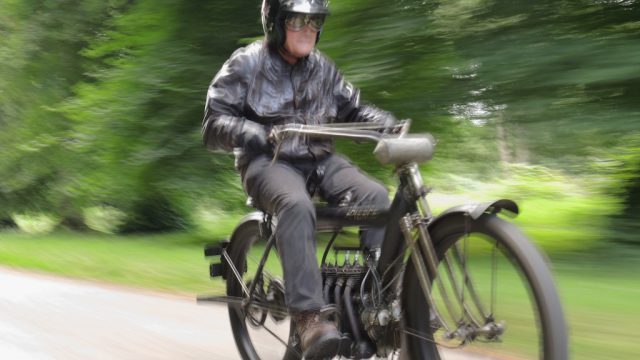
Early examples of the Pierce Four had no clutch and fixed gearing with shaft final drive, like the FN, but the 1910 Four featured a multi-plate clutch and two-speed transmission, still with shaft final drive via a crown wheel and pinion in the rear wheel, but with a secondary pedal-driven chain crank for ‘light pedal assistance’ when climbing hills, as well as to get the engine started in the first place. Ignition to fire the 18mm sparkplugs was provided by a Berling M42 magneto manufactured locally in Buffalo by the Ericsson Mfr. Co., positioned in front of the engine and driven off the three-bearing built-up crank. This featured machined cast iron three-ring pistons mounted on slender steel conrods running on plain bearings, and also drove both the force feed oil pump as well as the twin camshafts operating the valves. The ignition could be advanced or retarded by rotating the right wooden twistgrip, while the throttle was on the left, the opposite of today.
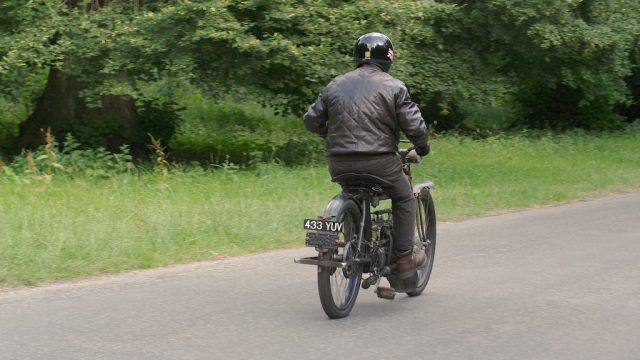
The Pierce Four ran on 28-inch steel-rimmed wheels fitted with 2.50-section beaded-edge tyres, and there was no rear suspension, though the sturdy saddle made in New York by the Mesinger Bicycle Saddle Co. was sufficiently well sprung to alleviate some degree of road shock. But the leading-link fork bore the emblem of the Pierce Hygienic Cushion Frame, which in practice meant the operation via a parallelogram linkage of a spring damper mounted in front of the bicycle-type steering head, whose stem rotated in ball bearings top and bottom. There was no front brake, but instead from 1910 onwards Pierce employed two acting on the seven-inch/178 mm rear hub, one within it operated by counter-pedalling, and the other an external contracting band acting on the brake rim, and operated via a lever on the right handlebar. Claimed dry weight was 275lb/125kg.
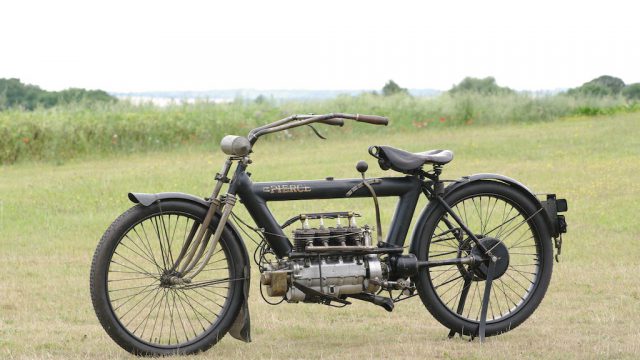
Fast and well made, the Pierce Four was capable of speeds up to 60 mph/100 kmh, and soon had a string of city-to-city endurance race wins to its credit, many of them achieved by Percy Pierce himself. But it was an expensive machine whose sales were limited. First sold through Pierce bicycle dealers with a $325 sticker price in 1909 at a time when the USA’s average annual income was $1,140, the price was raised to $400 in 1912, compared to the Ford Model T car priced at $525. Though Pierce then introduced a less expensive 592cc single-cylinder model alongside the Four, each bike was rumoured to cost more than its retail price to build thanks to so many quality parts being included. Losing money on every motorcycle it manufactured brought inevitable financial travails which forced the Pierce Cycle Company to close its doors in 1914 after fewer than 500 machines had been built. This came against the backdrop of a general economic slowdown in the USA, combined with rising production costs and difficulty in obtaining materials and components, all attributable in part at least to the onset of WWI. A further issue was the growing competition posed by the rampant auto industry, for American car builders had made rapid advances in the quality of their products, while embracing large-scale volume production methods. They were thus increasingly able to offer four-wheeled transport at ever lower prices, sometimes even cheaper than motorcycles. History repeated itself 45 years later in Italy, with the 1957 advent of the Fiat 500.

With few Pierce Fours ever built and fewer still surviving today, the appearance of a completely original one bearing engine no. 1590 for auction at Bonhams’ August 2012 Quail Lodge sale in California inevitably created some excitement, before it was sold for $137,000 (then £106,229) to an American-born enthusiast who’s been resident for many decades in the UK. Auction sale protocol prevents me from naming him, but he’s now put the bike up for sale again at the Bonhams Autumn Stafford Sale on October 15 http://www.bonhams.com/auctions/24131/ after extensively recommissioning what was a basically complete but semi-derelict example of America’s first Four, which has enjoyed only four owners from new. It was put into dry barn storage in 1932 when it passed to the second owner, from which it emerged 75 years later when purchased by the third keeper. He displayed it as part of a prominent private collection before selling it at the Quail Lodge sale to the present anonymous owner, who himself has a substantial collection of prized motorcycles, all of which are regularly ridden and, where appropriate, raced.
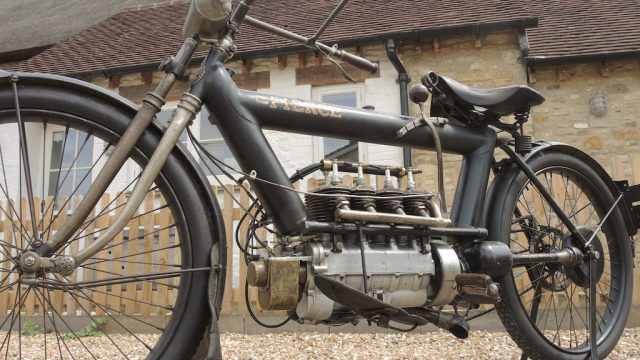
“I already had a Pierce single, so when I bought the Four it was my firm intention to recommission it completely,” he declares. “It was externally complete – but I wasn’t expecting it to be so totally worn out inside! Still, needs must – so we’ve essentially made it a runner again while preserving the patina of time. There was no question of repainting it, and I’ve retained all the original parts we replaced. But the engine needed a lot of work, though we now have it running, and it’s insured and taxed for the road here in the UK, complete with an MoT certificate!” Nigel Parrott Precision Engineering of Heathfield, West Sussex, is one of the world’s leading restorers of Veteran cars, and is responsible for refurbishing many of the entries in the annual London to Brighton pre-1905 Veteran car run. They were entrusted with rebuilding the Pierce Four’s engine, and after grappling with the highly complicated and absolutely abnormal techniques by today’s standards that are required to ride it, I can only applaud them for making the past live again so effectively.
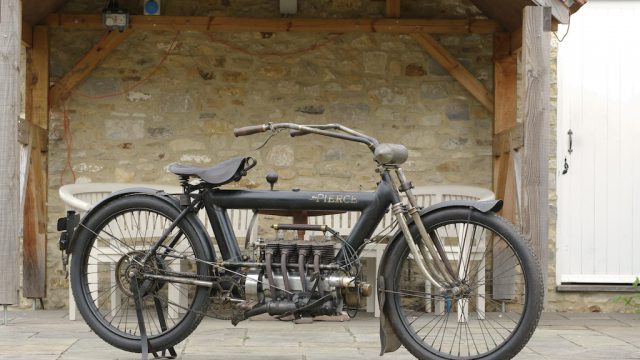
Simply firing up the Pierce’s engine in the first place is the single most difficult thing to do, but fortunately I had help on hand in the person of John Rhodes, who looks after many of the owner’s historic motorcycles. John first demonstrated how to do it, resulting in the motor blaring into life with the flat thrum of a vintage car. OK – my turn. Unless you have a gradient to pedal down, it’s best to put the bike on the stand, hop aboard, then move the scimitar-shaped gear lever on the left into Neutral, and start pedalling to build up momentum. There’s no ignition switch – you just turn on the fuel tap, sit on the seat and start cranking, while setting the left hand throttle about half open – it’s a positive setting, with no return spring – and turning the right twistgrip clockwise to fully retard the ignition. While still pedalling you then carefully ease the gear lever one notch forward to Coast, which automatically engages the clutch and starts the engine firing, while you gradually advance the sparks. Once you’re satisfied you’ve got it running properly, you then stick it back into Neutral, work the surprisingly effective external contracting band rear brake hard enough to stop the wheel turning, then dismount to pull the bike off the stand, and attach this to the clip on the rear mudguard. OK, so that was the easy bit: now comes the tricky part….
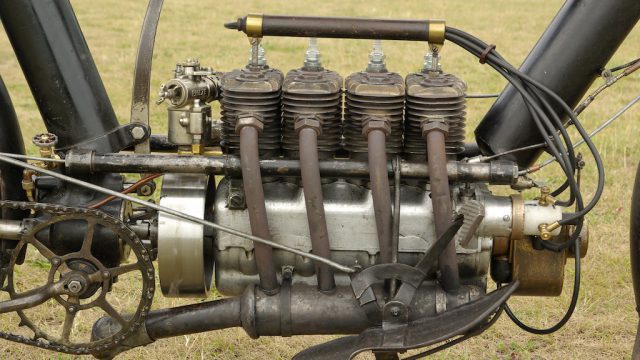
Hop back on board again and with any luck the engine is still running, in which case you must now back off the throttle to about one-third open, then ease the gear lever forward again, preferably while pedalling to get the bike off the mark. This time you must push it through Coast and into Low Speed – the equivalent of bottom gear in the two-speed transmission, as in Slow and Slower. It’s important to set the throttle ahead of this, because you obviously have other things in store for your left hand to attend to, while playing with the ignition advance on the right twistgrip to find a good setting for acceleration. Remember, there’s no clutch lever to operate, so it’s hard to describe how comparatively helpless you feel, as if you’re totally at the mercy of the mechanical minions making momentum on this Early American. Once you reach Low you can then stop pedalling, sit back and relish the satisfaction of getting this Early American up and running. Want to go faster? Then you need to back off the throttle to about one-quarter open, then pull the gearlever fully back towards you to select High Speed. I managed this OK, but what you cannot do is push the lever forward to move from High to Low on the move, especially if you’re climbing a hill and need a little more oomph. You have to stop at the bottom of the gradient, select Low Speed, and then hold it in that until you’ve climbed the hill and want to select High again. You need to plan ahead quite a bit when riding the Pierce Four!
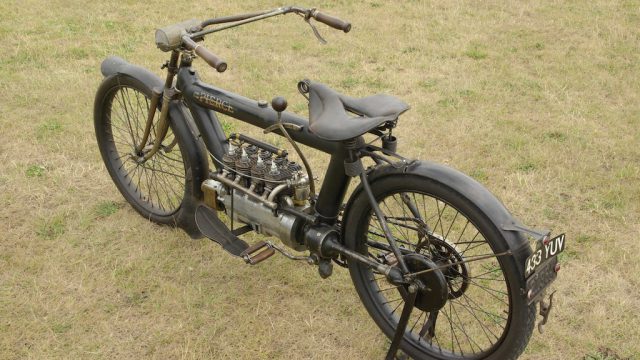
To begin with I found myself zig-zagging from one side of the road to another as I frantically tried to combine pedalling to keep up momentum with selecting bottom gear, leaving just one hand on the handlebar. The bicycle-type steering setup is very light, nervous even, especially because the Pierce Four’s handlebars are WAY-Y-Y-Y pulled back, so even minor steering inputs produce a huge response. Luckily, we’d picked an ultra-quiet road up in the Chiltern Hills to ride the bike, so I wasn’t too big a hazard to traffic, and once I’d sort-of mastered the art of getting it under way, I could appreciate the smooth-running engine’s finer qualities, for it is indeed absolutely Vibrationless, in contrast to similar era V-twins and singles I’ve ridden.

However, the biggest problems arose when I wanted to slow to take a tight corner, and especially to make a U-turn, since because the seat was mounted very low and far forward, there was insufficient room for the ‘bars to clear my legs if I parked my feet on the carefully-shaped foot-sized footboard – complete with instep support! See, our anonymous owner is a shortie – as befits someone who used to race 125GP bikes, and even once finished on the rostrum in a World Championship GP. This meant he had the riding position on the Pierce tailored to suit his stature, entailing my dismounting to push it around in a semi-circle for another pass past Naka-san’s camera lens, and inevitably, this ran the risk of stalling it, in which case….repeat all of the above!
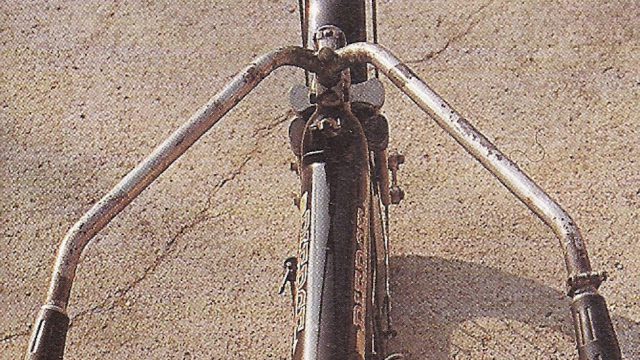
But by any standards riding the Pierce Four was an honour as well as a privilege, for this is a very important piece of American – global, even – two-wheeled living history. It’s a fabulous period piece, a living survivor of the pioneer days of motorcycling when the future was all to play for. Full marks to our anonymous owner for having ‘merely’ recommissioned it rather than restoring it, and thus destroying the truth of time. And thanks also to him for allowing me to experience what I freely admit is the most difficult motorcycle to start and ride that I’ve ever sampled – bar none!
